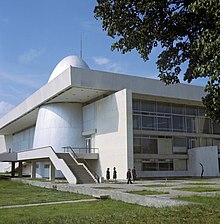
Back Tsiolkovskin kosmonautiikan valtionmuseo Finnish Musée d'État de l'histoire de l'astronautique C. E. Tsiolkovski French המוזיאון הממלכתי לתולדות החלל על שם ציולקובסקי HE Կ. Ե. Ցիոլկովսկու անվան տիեզերագնացության պատմության պետական թանգարան Armenian Państwowe Muzeum Historii Kosmonautyki im. K. Ciołkowskiego Polish Государственный музей истории космонавтики имени К. Э. Циолковского Russian Државни музеј историје космонаутике Циолковски Serbian Державний музей історії космонавтики імені К. Е. Ціолковського Ukrainian 齊奧爾科夫斯基州立宇宙歷史博物館 Chinese
 Main building | |
 | |
| Established | 3 October 1967 |
|---|---|
| Location | Kaluga |

the first satellite, Sputnik 1 (a ball under the ceiling);
the first spacesuits (lower-left corner);
the first human spaceflight module, Vostok 1 (center);
the first Molniya-type satellite (upper right corner);
the first space rover, Lunokhod 1 (bucket on wheels on the right);
the first space station, Salyut 1 (left);
the first modular space station, Mir (upper left).
The Konstantin E. Tsiolkovsky State Museum of the History of Cosmonautics (Russian: Государственный музей истории космонавтики имени К.Э.Циолковского) is the first museum in the world dedicated to the history of space exploration.[1] It was opened on 3 October 1967 in Kaluga, and is named after Konstantin Tsiolkovsky, a school master and rocket science pioneer who lived most of his life in this city. The driving force behind the creation of the museum was Sergei Korolyov, chief designer of RKK Energiya. The building was designed by Boris Barkhin, Evgeny Kireev, Nataliya Orlova, Valentin Strogy and Kirill Fomin, and the cornerstone was laid by Yuri Gagarin on 13 June 1961. The museum has over 100,000 visitors per year and has 127 employees, of whom 43 are curators.[2]
- ^ A site on the museum Archived 2006-11-10 at the Wayback Machine
- ^ Statistical information on the museum
© MMXXIII Rich X Search. We shall prevail. All rights reserved. Rich X Search